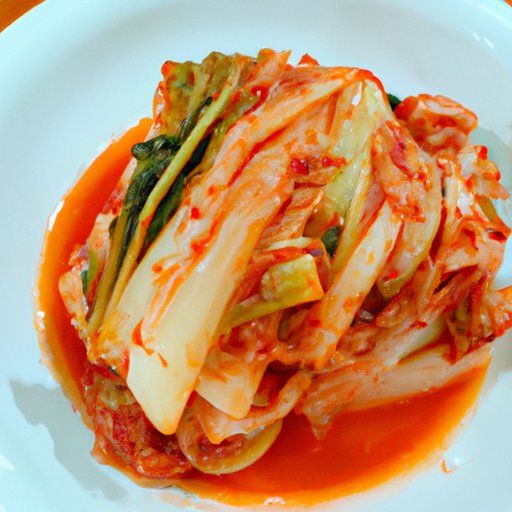
I. Introduction
Kimchi is a traditional Korean side dish made of fermented vegetables, most commonly napa cabbage and radishes, mixed with spices and seasonings. It is a staple in Korean cuisine, with variations found in different regions and households.
Learning how to make kimchi allows you to appreciate the art and science of fermentation, explore new flavors, and experience the cultural significance of the dish. In this beginner’s tutorial, we will guide you through the steps, secrets, and health benefits of making kimchi.
II. Step-by-Step Guide to Making Kimchi: A Beginner’s Tutorial
To make kimchi, you will need the following ingredients and equipment:
- Napa Cabbage, cut into bite-sized pieces
- Radish, cut into thin strips
- Korean pear, grated
- Garlic, finely chopped
- Ginger, finely chopped
- Red pepper flakes
- Fish sauce
- Sugar
- Salt
- Large mixing bowl
- Clean jars with lids
1. Preparation of ingredients: Rinse the cabbage and radish with water, sprinkle with salt, and leave for 1-2 hours to drain and soften. Rinse them again, and squeeze out excess water.
2. Mixing and seasoning: In a large mixing bowl, combine the cabbage, radish, pear, garlic, ginger, red pepper flakes, fish sauce, sugar, and additional salt to taste. Mix everything thoroughly with your hands or a spoon, making sure that the seasoning is evenly distributed.
3. Picking and storing: Pack the mixture tightly into clean jars, leaving some headspace for expansion during fermentation. Seal the jars tightly and leave them in a cool, dark place for 1-5 days, depending on your desired level of fermentation. Open the jars daily to release any gas buildup and taste the kimchi until it reaches your preferred flavor and texture. Once you are satisfied, store the kimchi in the refrigerator to slow down the fermentation and maturity process.
III. 5 Secrets to Perfect Kimchi: Tips and Tricks From a Korean Grandmother
For an authentic and delicious kimchi, consider these tips from a Korean grandmother:
- Use of the correct salt: Use sea salt or kosher salt, as iodized salt can inhibit fermentation and cause discoloration.
- Importance of quality ingredients: Use fresh, organic, and locally sourced vegetables and seasonings to retain their natural flavors and nutrients.
- Fermentation temperature control: Keep your kimchi jars at a consistent temperature of around 68-72°F to promote the growth of beneficial bacteria and avoid spoilage.
- Fermentation time adjustment: Depending on the temperature, humidity, and season, the fermentation process can be faster or slower. Taste your kimchi regularly to monitor its progress and adjust the fermentation time to your liking.
- Proper handling and storage: Use clean and sterile jars, utensils, and hands when making kimchi to avoid contamination. Keep your kimchi jars tightly sealed and refrigerated to maintain their freshness and quality.
IV. The Science Behind Kimchi: Fermentation and Health Benefits
Kimchi is a fermented food, which means that healthy bacteria break down the carbohydrates and proteins in the vegetables and convert them into lactic acid, acetic acid, and other by-products. This process not only gives kimchi its tangy and savory flavor but also enhances its nutritional value and health benefits.
During fermentation, kimchi undergoes changes that promote gut health, immunity, digestion, and anti-inflammatory effects. Kimchi is rich in probiotics, fiber, antioxidants, vitamins, and minerals, making it a superfood with various health benefits.
V. Modern Twists on Traditional Kimchi: Creative Variations to Spice Up Your Recipes
While traditional kimchi is delicious on its own, you can also use it to add flavor, texture, and nutrition to other dishes. Here are some ideas for creative kimchi variations:
- Kimchi Fried Rice: Cook some rice, peas, eggs, bacon, and kimchi in a pan with some oil and soy sauce for a flavorful and easy meal.
- Kimchi Pancakes: Mix some flour, water, eggs, scallions, and kimchi in a bowl, and fry small pancakes in a pan until golden brown and crispy.
- Kimchi Ramen: Cook some ramen noodles, bok choy, mushrooms, and kimchi in a pot with some chicken broth and sesame oil for a comforting and spicy soup.
Experiment with different flavors, textures, and cooking techniques to incorporate your favorite kimchi into your recipes. You can also try kimchi with different vegetables, such as cucumbers, carrots, apples, or pears, depending on your taste buds and creativity.
VI. From Farm to Fermentation: Exploring the Origins and Cultural Significance of Kimchi
Kimchi has a long history in Korea, evolving from a simple pickling method for preserving vegetables to a complex and diversified culinary tradition. Kimchi was initially a seasonal food made with root vegetables and stored in earthenware jars underground. Over time, Koreans introduced new ingredients, spices, and techniques, creating hundreds of types of kimchi with different tastes, textures, and colors.
Kimchi has also played a significant cultural role in Korea, symbolizing unity, hospitality, and identity. Korean families traditionally gather to make kimchi together, a ritual known as ‘kimjang,’ which reflects the values of cooperation, respect, and sharing. Kimchi is also a popular export and a source of national pride for Koreans, who celebrate kimchi festivals, contests, and museums.
VII. Conclusion
In conclusion, kimchi is more than just a spicy and flavorful dish; it is a window to the Korean culture, history, and science of fermentation. By learning how to make kimchi, you can explore new tastes, textures, and health benefits, as well as appreciate the creativity, diversity, and values of different communities. We encourage you to try making kimchi at home and share your experience with others, as kimchi is a dish that brings people together and celebrates life.





